The Association for Research in Vision and Ophthalmology (ARVO) meeting is full of compelling cornea abstracts. Thats what makes picking just a handful of them to cover in Review of Optometry each year so difficult.
That said, here are reports on contact lenses, cornea and dry eye that I feel have great clinical relevance. (Visit www.arvo.org for further information on each abstract and to check out others.).
Tears and Contact Lens Wear
Dry eye symptoms often go hand-in-hand with soft contact lens wear, and researchers in Japan think theyve discovered why. They assessed dryness, tear interference pattern (TIPCL) and non-invasive tear break-up time (NIBUT), and they evaluated tear volumes at the lower lids of 57 daily soft lens wearers who wore silicone hydrogel contact lenses.372 Decreased tear volume generated a thinner and unstable tear film on the lens, leading to an increase in patient dryness.
If we can enhance the tear film by increasing stability and volume, well prevent some of our soft lens patients from dropping out of lens wear. The tear film is also essential to successful lens wear, as it protects the eye from assorted insults.
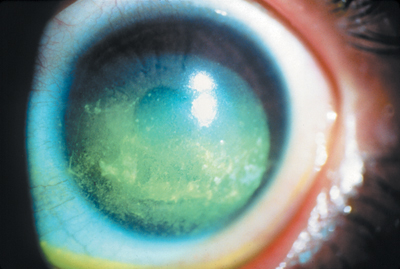 |
|
Decreased tear volume generated a thinner and unstable tear film on the patients who wore soft contact lenses. This increases patient dryness, according to researchers in Japan. |
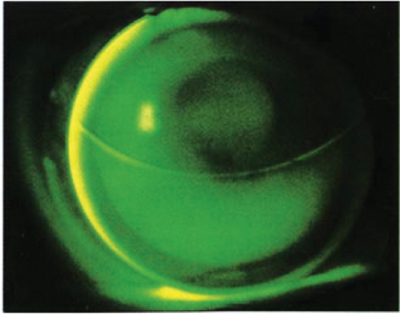 |
|
Blink-driven post-lens tear exchange is essential in gas permeable lens wear (crescent segmented gas permeable bifocal is shown above), as it precludes the lens from binding to the corneal surface and removes waste, say researches in Ohio. |
Adaptive Optics for Presbyopia
Prescribing contact lenses for presbyopic patients is often a challenge because designs that provide both distance and near vision are not suitable for everybody. Often, we must prescribe a biased distance lens for one eye and a biased reading lens for the other. But that may soon change, say researchers in Spain.373
 |
|
An adaptive optics instrument used to create customized contact lenses for presbyopic patients could save manufacturers several steps in designing lenses for these patients and may even lead to adaptive optics-created intraocular lenses for cataract patients. |
This approach could save manufacturers several steps in designing lenses for presbyopic patients, the researchers concluded.
Given this finding, patients past age 40 may one day wear contact lenses developed through adaptive optics. Or, perhaps, patients who undergo cataract surgery will receive intraocular lenses designed by adaptive optics to correct for both distance and near vision.
Contact Lens Solutions
Imagine this: You supply two contact lens patients with samples of various multipurpose contact lens solutions. When they return, one tells you she prefers product A, while the other touts product B. Sound familiar?
Researchers in Canada may have discovered why this happens.377 They studied the osmolarity, pH, viscosity and surface tension of several brands of multipurpose solutions. They found that several were hypo-osmotic compared with tears and that the pH of most solutions was close to neutral. The average viscosity of most of the products at room temperature was within 0.95 to 1.26 mPa.s, and within 0.70 to 0.83 nPa.s. Finally, the surface tension values for the products varied markedly.377
Because every patients pH and preference for osmolarity and salt concentration in the solution is different, these findings may, in part, explain why our patients have such a strong preference for certain multipurpose solutions. Someday, perhaps a tear film analysis can be done to determine individual solution preferences before we actually dispense a particular product.
Corneal Epithelial Barrier Functions
Previous studies suggest that the corneal epithelium in Asians vs. non-Asians is more susceptible to micro-trauma during contact lens wear. However, researchers in California dispelled these findings.378
The researchers measured the corneal epithelial permeability of 39 Asian and 40 non-Asian patients who had no prior history of contact lens wear. Using an automated fluorometer, the researchers obtained measurements on all 79 patients at least four hours after waking. Results revealed no fundamental difference in corneal epithelial barrier function between Asians and non-Asians.
The researchers proposed that the higher increase of corneal epithelial permeability seen in Asians after overnight soft contact lens wear may be due to vertical palpebral aperture size, presumed higher lid tension or thinner post-tear thicknessall of which lead to disruption of the corneal epithelium.
Dry Eye Treatment
Although Restasis (cyclosporine, 0.05%, Allergan) has provided relief to many dry eye patients, some patients have had to wait as long as six months for the drug to work. However, patients who were placed on Restasis pre- and post-cataract surgery found relief of their surgery-induced dry eye symptoms one month after the procedure, say researchers in New York.410
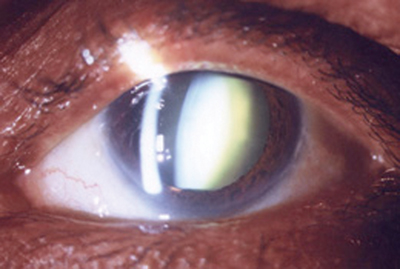 |
|
Cyclosporine is not only effective in reducing the frequent symptoms of burning and foreign-body sensation that accompany cataract surgery, but patients achieve faster relief than previously thought with the drug. |
This indicates that cyclosporine is not only effective in reducing the frequent symptoms of burning and foreign-body sensation that accompany cataract surgery, but that these patients achieve faster relief than previously thought with the drug.
Meanwhile, researchers in France confirmed that polyunsaturated fatty acids may alleviate dry eye symptoms.414 In a double-masked pilot study, 70 patients who had mild to moderate dry eye syndrome randomly received a supplement that contains omega-3 and omega-6 fatty acids and various vitamins, or a placebo.
Some 61% of those in the supplement group had improvements in reflex tearing and conjunctival hyperemia vs. 36% in the placebo group. Schirmer tests, tear break-up time, and fluorescein and lissamine green staining also improved with the supplement vs. the placebo, but these differences were not statistically significant. This was also the case with major histocompatibility complex Class II molecules, prostaglandin tear secretion and feelings of discomfort.
Although polyunsaturated fatty acids seem to alleviate some dry eye symptoms and may be a new useful addition to our dry eye treatment armamentarium, the results of this study must be confirmed by a larger group of subjects, the researchers concluded.
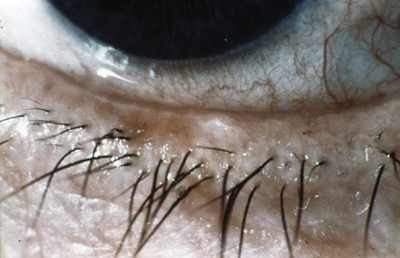 |
|
Warm compress therapy (on meibomian gland disease patients for instance) should be prescribed based on the dry-eye patients work schedule, as this therapy causes a temporary decrease in visual acuity and/or blurred vision, say researchers in Boston. |
Results showed that 78% of the subjects who used warm compresses experienced a temporary (30 minutes) decrease in visual acuity and/or blurred vision. There was no change in visual acuity or subjective impression visual acuity in the untouched eyes. Autorefrac-tion showed no significant changes in either eye.
These findings suggest that we might want to prescribe warm compresses in the evening hours only, as we do not want our patients to ex-perience vision problems when driving to work. Or, if the patient works at night, we should generally recommend warm compresses in the mornings.
Conditions Linked to Dry Eye
Many women who have fibromyalgia present with Sjgrens syndrome and severe dry eye. As a result, many of us assume there is a connection. But researchers in Canada refute this assumption.418
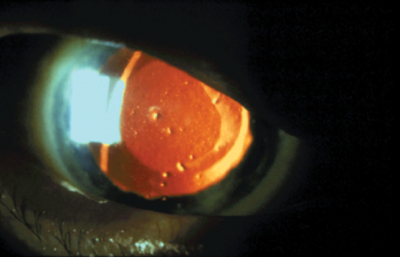 |
|
Many women who have fibromyalgia present with Sjgrens syndrome (shown above) and severe dry eye. As a result, many of us assume there is a connection. But researchers in Canada refute this assumption. This suggests there may be a neuropathic component to some of these patients. |
These findings beg the question: Is there a neuropathic component to some of these patients who report severe dryness? Our brains control our assessment of how everything in our body feels, including our eyes; and there are some people who present clinically with minimal dryness, yet they report horrible symptoms of pain. So, we, as practitioners, need to also address the psychological implications of diseases such as fibromyalgia.
On the other hand, not all patients with a lack of clinical indicators have a neuropathic component, say researchers in Canada.427
The researchers looked at 39 healthy post-menopausal women who did not wear contact lenses or use hormone replacement therapy and categorized them as symptomatic or asymptomatic for dry eye.427
 |
|
While some patients dry eye may be psychologically induced, this may not be the case with post-menopausal patients, as their symptoms worsen throughout the day. This finding discredits our clinical measurements on these patients and gives greater validity to dry eye questionnaires. |
While some patients dry eye may be psychologically induced, this may not be the case with post-menopausal patients. Their symptoms tend to worsen throughout the day, discrediting our clinical measurements and giving greater validity to dry eye questionnaires.
Finally, these results may allow for a differential diagnosis, as patients who have blepharitis are often worse in the morning, whereas this dryness groups symptomology increases over the course of the day.
Dr. Shovlin is in group practice in Scranton, Pa. He edits Review of Optometrys Cornea and Contact Lens Q&A column and is clinical editor for Review of Cornea and Contact Lenses. Check out Highlights of ARVO 2006 in the May issue of Review of Cornea and Contact Lenses for more abstracts.
370. Thota S, Perrigin J, Miller W, et al. conjunctival flaps in silicone hydrogel lens wearers.
372. Maruyama K, Yokoi N, Kinoshita S. Relationship be-tween dryness and tear dynamics during soft contact lens wear.
373. Manzanera S, Prieto PM, Ayala DB, et al. Designing and testing contact lenses for presbyopia with adaptive optics.
377. Dalton KN, Rogers R, Jones L. Physical properties of multi-purpose contact lens solutions.
378. Hsiao C, Truong TN, Lin MC. Does ethnicity play a role in corneal epithelial barrier function in non-contact lens wearers?
386. Fink BA, Gardner-Patterson H, Mitchell G, et al. A physiological index of post-lens tear exchange over a GP Dk/t Range of 80 to 208.
410. Roberts CW. Dry eye symptoms following cataract surgery.
414. Garcher C, Passemard M, O.Lafontaine P, et al. Im-provement of dry eye symptoms with polyunsaturated fatty acids.
418. Caffery B, Bookman A. The prevalence of fibromyalgia in Sjgrens syndrome and severe dry eye disease.
427. Srinivasan S, Jones L, Joyce E, et al. Clinical signs and symptoms in postmenopausal females with and without symptoms of dry eye.

